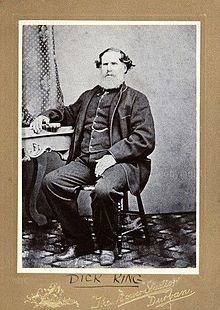Richard Philip King
| Dick King | |
|---|---|
 |
|
| Born |
26 November 1811 Dursley, Gloucestershire, England |
| Died | 10 November 1871 (aged 59) Isipingo, KwaZulu-Natal, South Africa |
Richard Philip "Dick" King (1813–1871) was an English trader and colonist at Port Natal, a British trading station in the region now known as KwaZulu-Natal. He is best known for a historic horseback ride in 1842, where he completed a journey of 960 kilometres (600 mi) in 10 days, to request help for the besieged British garrison at Port Natal (now the Old Fort, Durban).
Dick King was born on 26 November 1811 in Dursley in the English county of Gloucestershire. He died on 10 November 1871 in Isipingo, KwaZulu-Natal, South Africa. His family emigrated to the Albany district of the Cape Colony in 1820, as part of the settler program. In 1828 however his family resettled to the then frontier region of Port Natal, when Dick was about 15 years of age. His first employment was as a wagon driver for the pioneer traders. In reverend Francis Owen's company he met Zulu chief Dingane, and also got acquainted with captain Allen Gardiner.
In February 1835, when Dick King was already at Port Natal, Jan Gerritze Bantjes arrived with Petrus Lafras Uys on the "Kommissitrek" from Grahamstown. Bantjes was Uys's scribe. At Port Natal Bantjes did sketches of the bay area, the Berea and around the Mgeni River and made notes for Uys regarding the potential of the bay as a possible new port and capital of the new Boer homeland they were hoping to start. This was done over a period of weeks. Dick King (22) and Jan Gerritze Bantjes (17) went elephant hunting together with Alexander Biggar (1781-1838) who was a professional hunter, (Bantjes was fluent in both English and Dutch) and Dick and Jan Gerritze became well acquainted striking up a friendship during the weeks at Port Natal. Together with Johannes Uys, brother of Petrus Uys, they attempted to visit Dingaan on the land grant issue at Uys' request, but due to the Tugela being in full flood, they were forced to return to their laarger at the mouth of the Mvoti River and then back to Port Natal without consolidating the Zulu King's perspective on the issue. On their eventual return to Grahamstown in the Cape, it was Bantjes who at Uys's request, drew up the Natalland (Natalialand) Report that would be the catalyst that started the Great Trek from the Cape to the interior and Natal. Bantjes would later write the famous Retief/Dingaan Treaty that would change South African history forever.
Dick King first came to prominence after the 1838 murders of the Voortrekker leader Pieter Retief and his delegation at the kraal of the Zulu chief Dingane. George Champion of the American Board of Commissioners for Foreign Missions who heard of the murders notified Port Natal. They sent Dick King to warn his 18-year-old son, George, and others who were 120 miles (200 km) inland at the Voortrekker camps. Dick King departed immediately on foot, accompanied by a number of natives. Despite covering the distance in four days by walking day and night, they arrived just after the van Rensburg voortrekker camp was attacked. They reached the vicinity of the next camp, near present-day Estcourt, just as the attack on it started on 17 February 1838. Though cut off from the Gerrit Maritz laager, he participated in its defence, but was unable to prevent the death of George, who was further inland at the Blaauwekrans river. 600 Boers, including women and children, died in the surprise attacks though others managed to survive the heavy and sustained Zulu onslaughts.
...
Wikipedia
